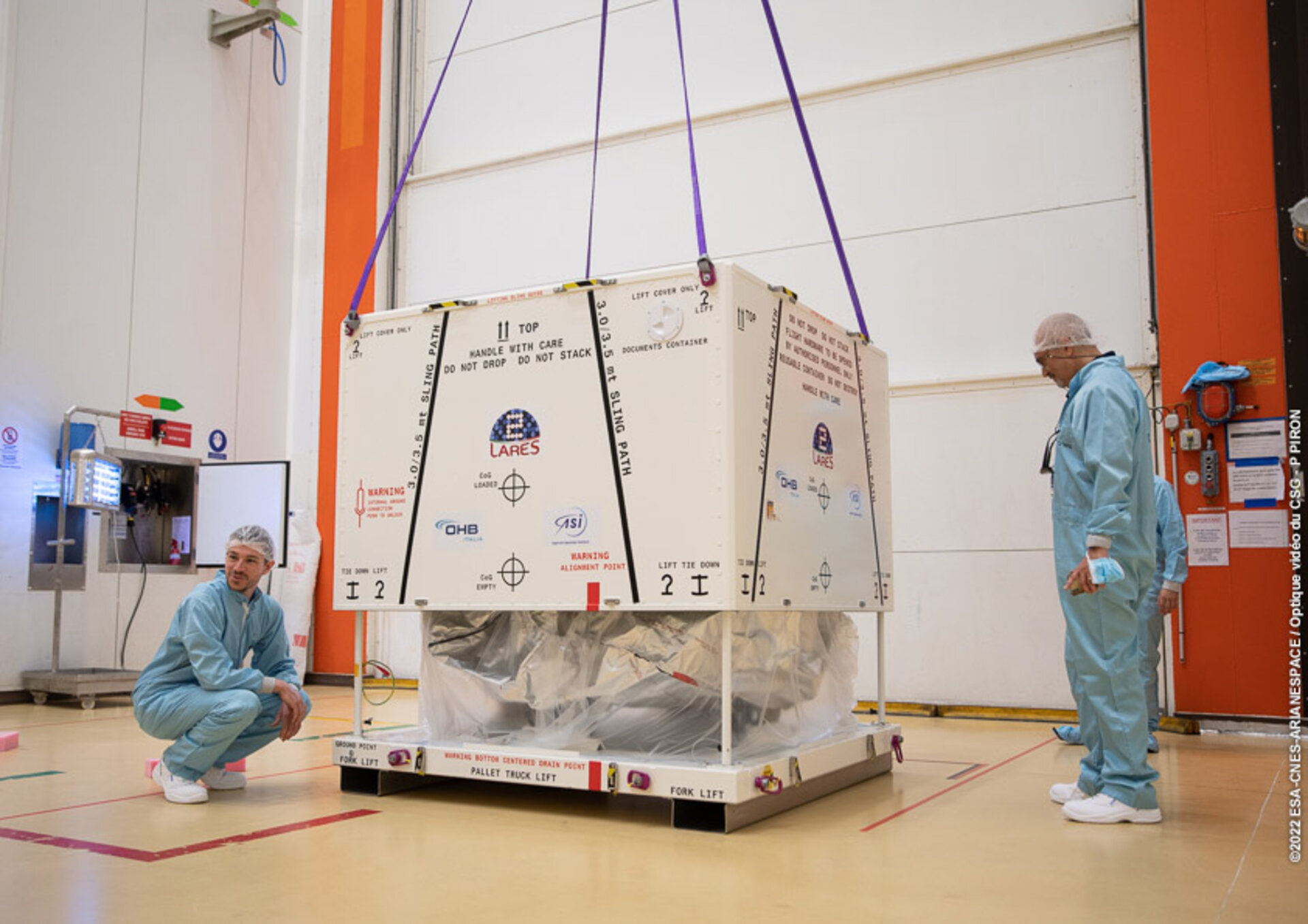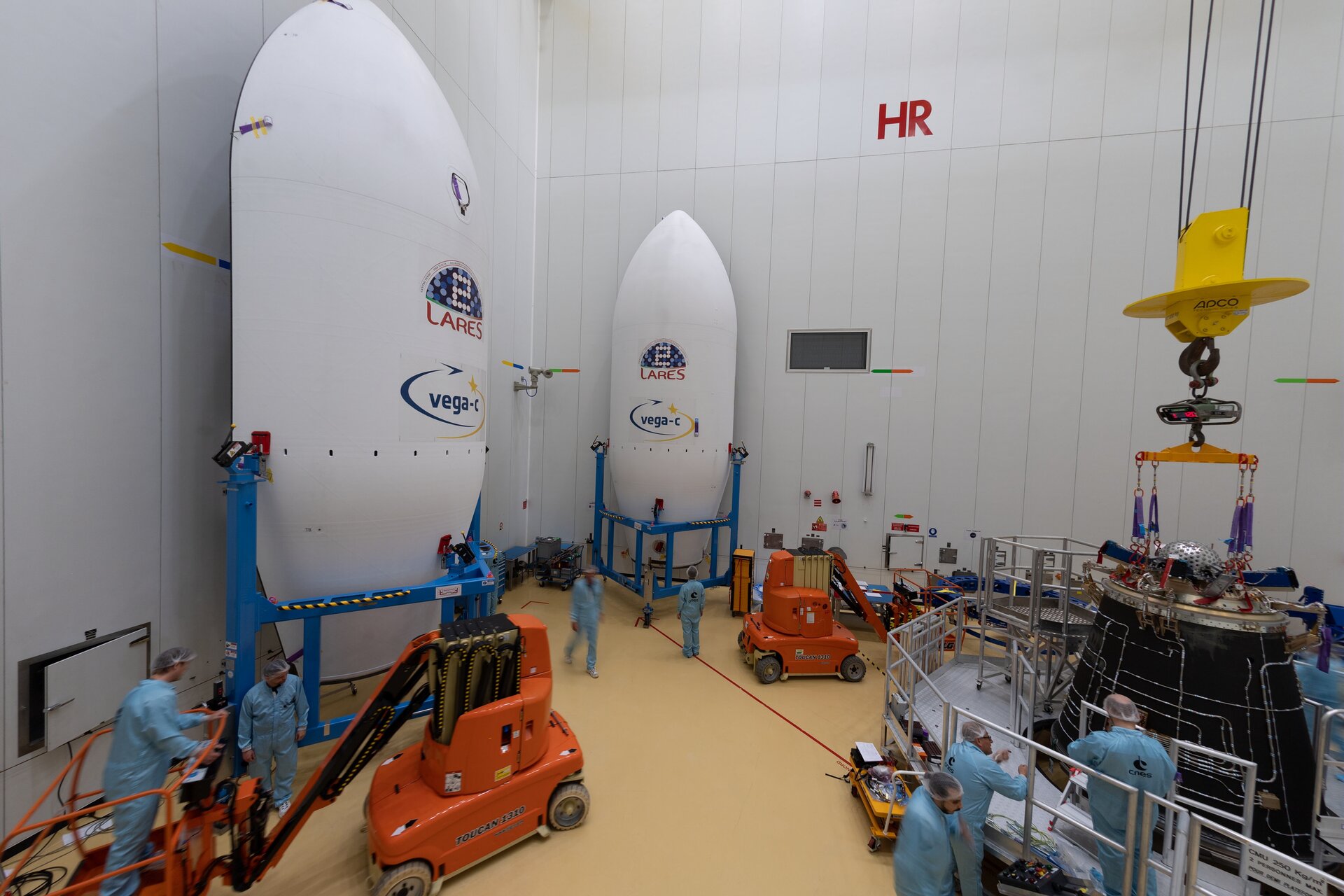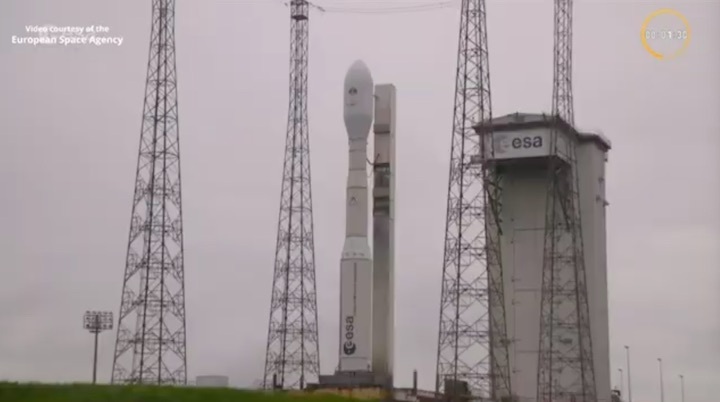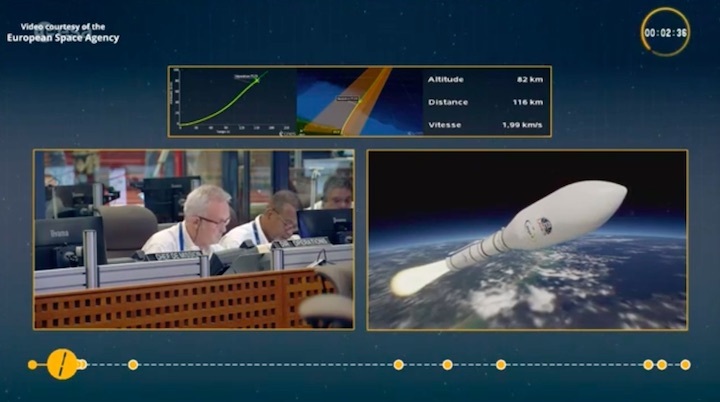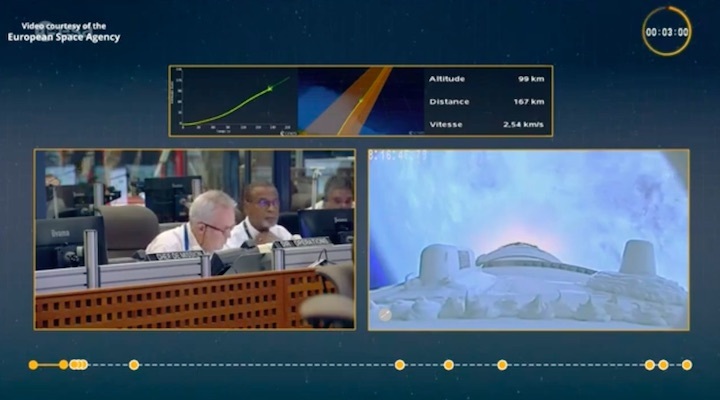28.04.2022
Launcher integration begins for Vega-C inaugural flight VV21

Launcher integration for the inaugural flight of Vega-C began with the P120 solid-fuel main stage being delivered to the Vega Launch Zone (Zone de Lancement Vega, or ZLV) at Europe's Spaceport in Kourou, French Guiana on 15 April 2022.
For this inaugural flight, the principal payload will be LARES-2, a scientific mission of the Italian Space Agency (ASI). Also onboard will be six European research CubeSats.
On the wave of Vega’s success, Member States at the ESA Ministerial meeting in December 2014 agreed to develop the more powerful Vega-C to respond to an evolving market and to long-term institutional needs.
Vega-C increases performance from Vega’s current 1.5 t to about 2.2 t in a reference 700 km polar orbit, covering identified European institutional users’ mission needs, with no increase in launch service and operating costs.
The participating states in this development are: Austria, Belgium, the Czech Republic, France, Germany, Ireland, Italy, the Netherlands, Norway, Romania, Spain, Sweden and Switzerland.
Vega-C will also accommodate the flight-proven Small Spacecraft Mission Service (SSMS) dispenser, which further reduces cost-to-orbit by enabling rideshare missions, with or without a large, primary payload.
Quelle: ESA
----
Update: 8.06.2022
.
N° 27–2022: Invitation to media: Inaugural launch of Vega-C, flight VV21

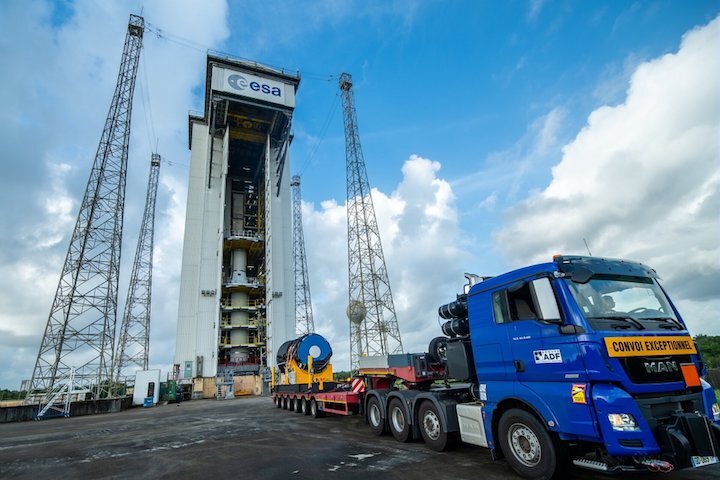
Media representatives are invited to witness the inaugural launch of Vega-C, either from Europe’s Spaceport in French Guiana or from ESA’s ESRIN facility in Frascati, Italy. The launch is currently planned for 7 July 2022 at 08:13 in French Guiana, 13:13 CEST in Italy.
A pre-launch online media briefing is planned for 30 June 2022.
At the Spaceport, journalists may view the launch from the media centre at the Jupiter control complex, where there will be interview opportunities with representatives of ESA, Avio, ASI, Arianespace and CNES. Spokespeople will be available at the ESRIN event.
Also at the Spaceport, journalists may have the opportunity to visit facilities related to Ariane 5 and Ariane 6.
Vega-C is a single body rocket about 35 m high with a mass at liftoff of 210 tonnes. It is able to place about 2200 kg in a reference 700 km-polar orbit. Using a new range of payload carriers, Vega-C will be able to accommodate cargo of different shapes and sizes ranging from multiple small satellites as small as one kilogram up to a single large payload. Ongoing developments will extend Vega-C capabilities to include in-orbit operations, and return missions using ESA's Space Rider reentry vehicle.
For VV21, Vega-C’s principal payload will be LARES-2, a scientific mission of the Italian Space Agency (ASI). Six CubeSats built by European universities and research establishments will be orbited as secondary payloads.
Spaceport draft programme
Tuesday 5 July – Friday 8 July 2022
- Visit of facilities: Spaceport, Ariane 5, Ariane 6; details to be confirmed
- Vega-C VV21 Launch (7 July 2022)
ESRIN draft programme
- Vega-C VV21 Launch (7 July 2022)
Online pre-launch press briefing
Thursday 30 June 2022
A detailed programme will be available closer to the date. A variety of high-level experts and spokespersons are available for interviews. A detailed programme will be available closer to the date.
Quelle: ESA
----
Update: 17.06.2022
.
Vega-C set for inaugural launch
ESA’s new medium-lift Vega-C rocket is nearly ready for its inaugural flight, with its four fully-stacked stages now ready for payload integration, final checks and launch from Europe’s Spaceport in French Guiana.
Flight VV21 will lift off as soon as 7 July, pending suitable conditions for launch.
Vega-C represents a dramatic capability boost compared to its predecessor, Vega, which has flown since 2012. With new first and second stages and an uprated fourth stage, Vega-C increases performance from Vega’s 1.5 t to about 2.2 t in a reference 700 km polar orbit.
Vega-C features a new, more powerful first stage, P120C, based on Vega’s P80. Atop that is a new second stage, Zefiro-40, and then the same Zefiro-9 third stage as used on Vega.
The re-ignitable upper stage is also improved. AVUM+ has increased liquid propellant capacity, to deliver payloads to multiple orbits depending on mission requirements and to allow for longer operational time in space, to enable extended missions.
The P120C motor will do double service, with either two or four units acting as strap-on boosters for Ariane 6. Sharing this component streamlines industrial efficiency and improves cost-effectiveness of both launchers.
With its larger main stages and bigger fairing – which doubles the payload volume compared to Vega – Vega-C measures 34.8 m high, nearly 5 m taller than Vega.
The new launcher configuration delivers a significant improvement in launch system flexibility. Vega-C can orbit larger satellites, two main payloads or can accommodate various arrangements for rideshare missions. ESA’s upcoming Space Rider return-to-Earth vehicle will be launched to orbit on Vega-C.

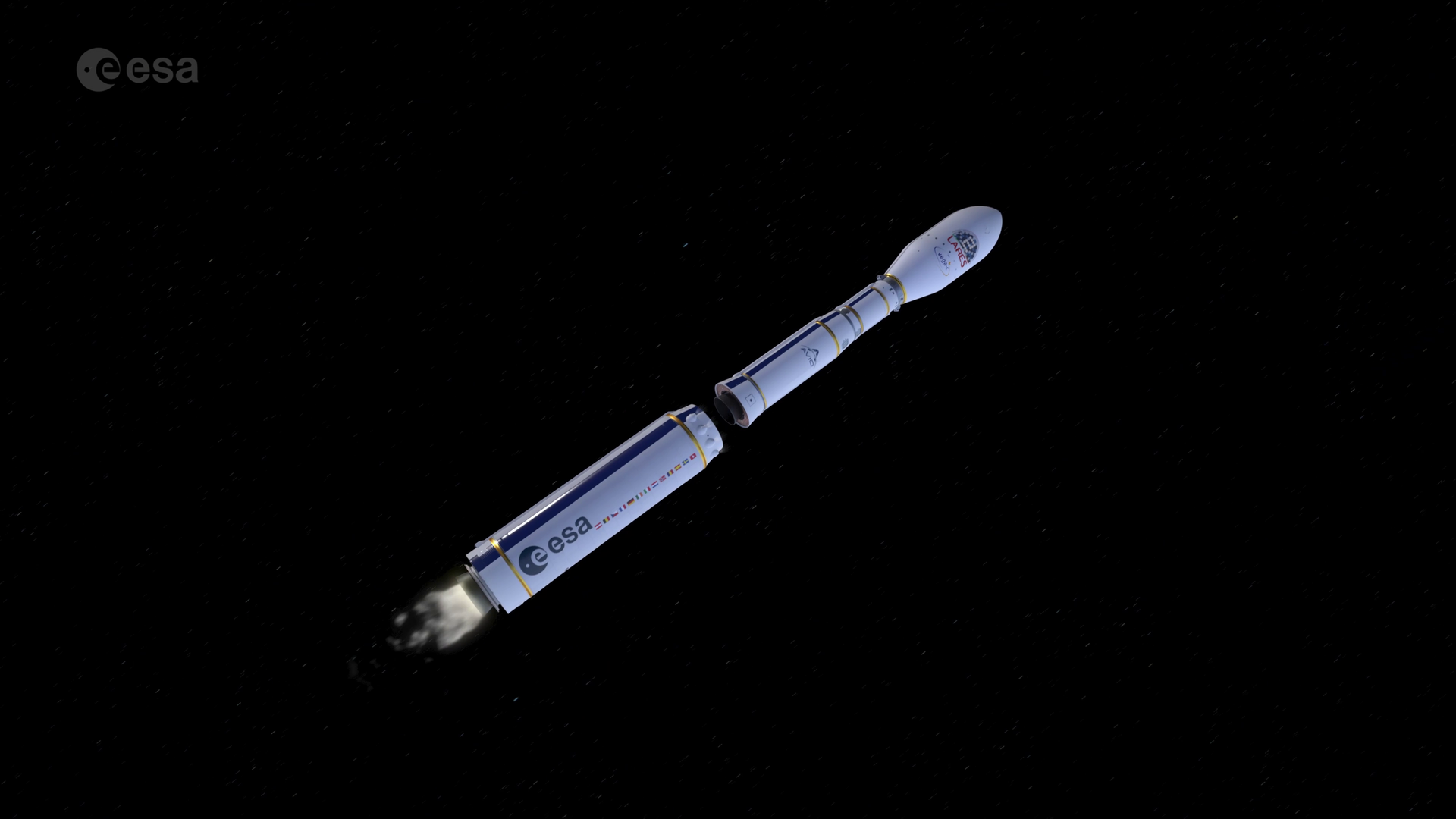
Access the video
RELATIVITY PAYLOAD
The main payload on this inaugural flight is LARES-2, a scientific mission of the Italian Space Agency (ASI). Once in orbit, LARES-2’s precise path will be tracked by laser, from ground stations. The purpose of the mission is to measure the so-called frame-dragging effect, a distortion of space-time caused by the rotation of a massive body such as Earth as predicted by Einstein’s General Theory of Relativity. Its predecessor, the similar LARES, was the main payload on the 2012 inaugural flight of Vega.
Six CubeSats make a secondary payload package. AstroBio CubeSat (Italy) will test a solution for detecting biomolecules in space. Greencube (Italy) carries an experiment to grow plants in microgravity. ALPHA (Italy) aims to help understand phenomena related to Earth’s magnetosphere, such as the Northern and Southern Lights.
Three other CubeSats – Trisat-R (Slovenia), MTCube-2 (France) and Celesta (France) will study the effects of a harsh radiation environment on electronic systems.
CHALLENGING MISSION
As with any inaugural launch, this is a challenging mission. “Vega-C features major enhancements from Vega, both in the rocket and its ground infrastructure,” says Renato Lafranconi, Vega programmes manager. “We’ve developed a new configuration with significant changes to many features of a proven concept, but the goal is to deliver major improvements in performance and competitiveness.”
ESA’s Director of Space Transportation, Daniel Neuenschwander stresses that Vega-C will work alongside the Ariane 6 heavy lifter to ensure Europe maintains flexible, competitive – and, critically, autonomous – launch capabilities: “With Vega-C and Ariane 6, Europe will have a flexible, independent solution for a fast-changing launch market.
“And, these two systems are the foundation of a development plan that will serve European institutions and commercial partners, opening a new chapter of European services.”
ESA Member States participating in Vega-C are Austria, Belgium, the Czech Republic, France, Germany, Ireland, Italy, the Netherlands, Norway, Romania, Spain, Sweden and Switzerland.
Quelle: ESA
----
Update: 6.07.2022
.
Vega-C set for inaugural launch

ESA’s new medium-lift Vega-C rocket is nearly ready for its inaugural flight, with its four stages stacked stages and ready to receive the payload fairing before final checks and launch from Europe’s Spaceport in French Guiana.
Flight VV21 will lift off as soon as 13 July, pending suitable conditions for launch.
Vega-C represents a dramatic capability boost compared to its predecessor, Vega, which has flown since 2012. With new first and second stages and an uprated fourth stage, Vega-C increases performance from Vega’s 1.5 t to about 2.2 t in a reference 700 km polar orbit.
Vega-C features a new, more powerful first stage, P120C, based on Vega’s P80. Atop that is a new second stage, Zefiro-40, and then the same Zefiro-9 third stage as used on Vega.
The re-ignitable upper stage is also improved. AVUM+ has increased liquid propellant capacity, to deliver payloads to multiple orbits depending on mission requirements and to allow for longer operational time in space, to enable extended missions.
The P120C motor will do double service, with either two or four units acting as strap-on boosters for Ariane 6. Sharing this component streamlines industrial efficiency and improves cost-effectiveness of both launchers.
With its larger main stages and bigger fairing – which doubles the payload volume compared to Vega – Vega-C measures 34.8 m high, nearly 5 m taller than Vega.
The new launcher configuration delivers a significant improvement in launch system flexibility. Vega-C can orbit larger satellites, two main payloads or can accommodate various arrangements for rideshare missions. ESA’s upcoming Space Rider return-to-Earth vehicle will be launched to orbit on Vega-C.


Access the video
RELATIVITY PAYLOAD
The main payload on this inaugural flight is LARES-2, a scientific mission of the Italian Space Agency (ASI). Once in orbit, LARES-2’s precise path will be tracked by laser, from ground stations. The purpose of the mission is to measure the so-called frame-dragging effect, a distortion of space-time caused by the rotation of a massive body such as Earth as predicted by Einstein’s General Theory of Relativity. Its predecessor, the similar LARES, was the main payload on the 2012 inaugural flight of Vega.
Six CubeSats make a secondary payload package. AstroBio CubeSat (Italy) will test a solution for detecting biomolecules in space. Greencube (Italy) carries an experiment to grow plants in microgravity. ALPHA (Italy) aims to help understand phenomena related to Earth’s magnetosphere, such as the Northern and Southern Lights.
Three other CubeSats – Trisat-R (Slovenia), MTCube-2 (France) and Celesta (France) will study the effects of a harsh radiation environment on electronic systems.
CHALLENGING MISSION
As with any inaugural launch, this is a challenging mission. “Vega-C features major enhancements from Vega, both in the rocket and its ground infrastructure,” says Renato Lafranconi, Vega programmes manager. “We’ve developed a new configuration with significant changes to many features of a proven concept, but the goal is to deliver major improvements in performance and competitiveness.”
ESA’s Director of Space Transportation, Daniel Neuenschwander stresses that Vega-C will work alongside the Ariane 6 heavy lifter to ensure Europe maintains flexible, competitive – and, critically, autonomous – launch capabilities: “With Vega-C and Ariane 6, Europe will have a flexible, independent solution for a fast-changing launch market.
“And, these two systems are the foundation of a development plan that will serve European institutions and commercial partners, opening a new chapter of European services.”
ESA Member States participating in Vega-C are Austria, Belgium, the Czech Republic, France, Germany, Ireland, Italy, the Netherlands, Norway, Romania, Spain, Sweden and Switzerland.
Quelle: ESA
----
Update: 13.07.2022
.

